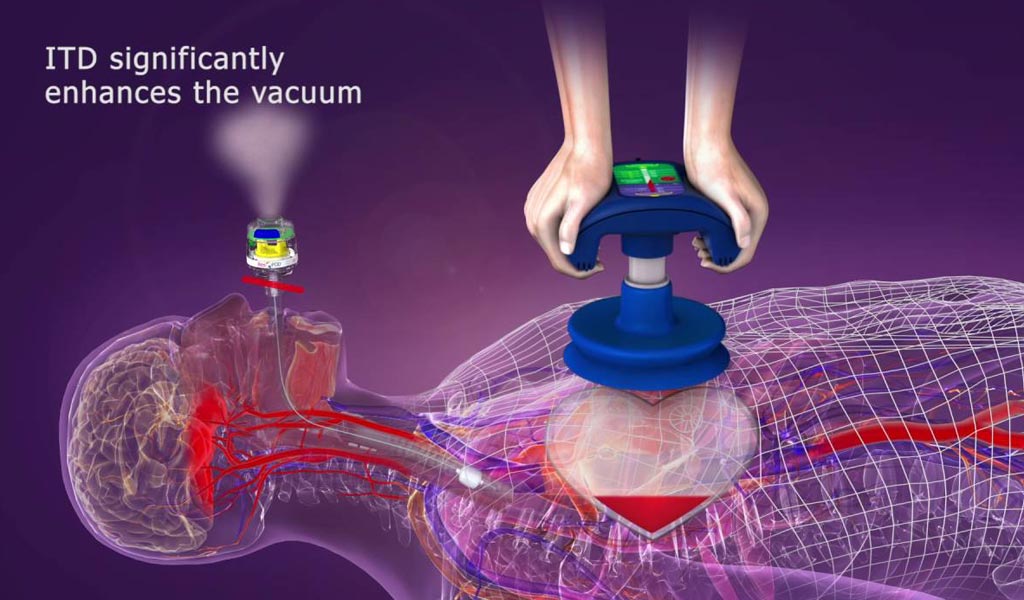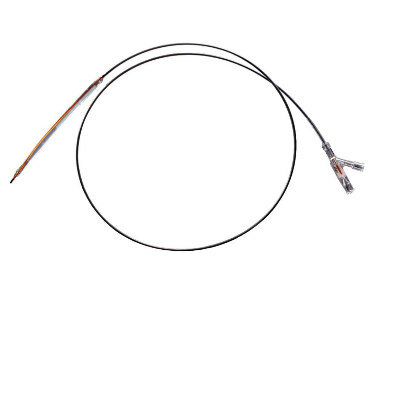Optimal CPR Compression Rate and Depth Identified
|
By HospiMedica International staff writers Posted on 02 Oct 2019 |

Image: The ResQCPR ITD device (Photo courtesy of ZOLL).
A new study concludes that cardiopulmonary resuscitation (CPR) outcomes are optimal when resuscitation is maintained for five minutes at about 107 compressions a minute.
Researchers at the University of Minnesota Medical School (UMN, Duluth, USA), Toho University (Tokyo, Japan), the University of Texas Southwestern Medical Center (UT Southwestern; Dallas, TX, USA), and other institutions conducted a cohort study involving 3,643 patients with out-of-hospital cardiac arrest (OHCA) to identify an ideal CPR compression and depth combination associated with the highest probability of functionally favorable survival. Responders used an impedance threshold device (ITD) that reduces the pressure in the chest and improves the return of venous blood to the heart.
The results showed that the identified optimal combination CPR for all patients was 107 compressions per minute at a depth of 4.7 cm. The optimal compression and depth combination remained the same regardless of age, sex, presenting cardiac rhythm, or CPR adjunct use, and was associated with much higher probabilities of survival (6%) when it was performed within 20% of the recommended value, as compared to 4.3% outside that range. The study was published on August 14, 2019, in JAMA Cardiology.
“The 6% survival among those patients compared with the 4% survival outside the combination zone would translate into several thousands of additional lives saved each year in the United States alone,” concluded corresponding author Paul Pepe, MD, MPH, of the UT department of emergency medicine, and colleagues. “Furthermore, if the ITD were used within the optimum four best cells for survivors, the 9.6% neurologic-intact survival that we detected would conservatively translate into at least 10,000 more lives saved annually.”
The ITD device used for the study is the ZOLL (Chelmsford, MA, USA) ResQCPR system, which provides perfusion on demand (POD) by regulating pressures in the thorax during a state of hypotension. This prevents unnecessary air from entering the chest during CPR; as the chest wall recoils, the vacuum in the thorax is greater. This enhanced vacuum pulls more blood back to the heart, doubling blood flow during CPR.
Related Links:
University of Minnesota Medical School
Toho University
University of Texas Southwestern Medical Center
Researchers at the University of Minnesota Medical School (UMN, Duluth, USA), Toho University (Tokyo, Japan), the University of Texas Southwestern Medical Center (UT Southwestern; Dallas, TX, USA), and other institutions conducted a cohort study involving 3,643 patients with out-of-hospital cardiac arrest (OHCA) to identify an ideal CPR compression and depth combination associated with the highest probability of functionally favorable survival. Responders used an impedance threshold device (ITD) that reduces the pressure in the chest and improves the return of venous blood to the heart.
The results showed that the identified optimal combination CPR for all patients was 107 compressions per minute at a depth of 4.7 cm. The optimal compression and depth combination remained the same regardless of age, sex, presenting cardiac rhythm, or CPR adjunct use, and was associated with much higher probabilities of survival (6%) when it was performed within 20% of the recommended value, as compared to 4.3% outside that range. The study was published on August 14, 2019, in JAMA Cardiology.
“The 6% survival among those patients compared with the 4% survival outside the combination zone would translate into several thousands of additional lives saved each year in the United States alone,” concluded corresponding author Paul Pepe, MD, MPH, of the UT department of emergency medicine, and colleagues. “Furthermore, if the ITD were used within the optimum four best cells for survivors, the 9.6% neurologic-intact survival that we detected would conservatively translate into at least 10,000 more lives saved annually.”
The ITD device used for the study is the ZOLL (Chelmsford, MA, USA) ResQCPR system, which provides perfusion on demand (POD) by regulating pressures in the thorax during a state of hypotension. This prevents unnecessary air from entering the chest during CPR; as the chest wall recoils, the vacuum in the thorax is greater. This enhanced vacuum pulls more blood back to the heart, doubling blood flow during CPR.
Related Links:
University of Minnesota Medical School
Toho University
University of Texas Southwestern Medical Center
Latest Critical Care News
- Ingestible Capsule Monitors Intestinal Inflammation
- Wireless Implantable Sensor Enables Continuous Endoleak Monitoring
- Pulse Oximeter Index Offers Non-Invasive Guides for Fluid Therapy
- Wearable Patch for Early Skin Cancer Detection to Reduce Unnecessary Biopsies
- 'Universal' Kidney to Match Any Blood Type
- Light-Based Technology to Measure Brain Blood Flow Could Diagnose Stroke and TBI
- AI Heart Attack Risk Assessment Tool Outperforms Existing Methods
- Smartphone Imaging System Enables Early Oral Cancer Detection
- Swallowable Pill-Sized Bioprinter Treats GI Tract Injuries

- Personalized Brain “Pacemakers” Could Help Patients with Hard-To-Treat Epilepsy
- Microscopic DNA Flower Robots to Enable Precision Medicine Delivery
- Origami Robots to Deliver Medicine Less Invasively and More Effectively
- Improved Cough-Detection Technology Aids Health Monitoring
- AI Identifies Children in ER Likely to Develop Sepsis Within 48 Hours
- New Radiofrequency Therapy Slows Glioblastoma Growth
- Battery-Free Wireless Multi-Sensing Platform Revolutionizes Pressure Injury Detection
Channels
Surgical Techniques
view channel
Robotic Assistant Delivers Ultra-Precision Injections with Rapid Setup Times
Age-related macular degeneration (AMD) is a leading cause of blindness worldwide, affecting nearly 200 million people, a figure expected to rise to 280 million by 2040. Current treatment involves doctors... Read more
Minimally Invasive Endoscopic Surgery Improves Severe Stroke Outcomes
Intracerebral hemorrhage, a type of stroke caused by bleeding deep within the brain, remains one of the most challenging neurological emergencies to treat. Accounting for about 15% of all strokes, it carries... Read morePatient Care
view channel
Revolutionary Automatic IV-Line Flushing Device to Enhance Infusion Care
More than 80% of in-hospital patients receive intravenous (IV) therapy. Every dose of IV medicine delivered in a small volume (<250 mL) infusion bag should be followed by subsequent flushing to ensure... Read more
VR Training Tool Combats Contamination of Portable Medical Equipment
Healthcare-associated infections (HAIs) impact one in every 31 patients, cause nearly 100,000 deaths each year, and cost USD 28.4 billion in direct medical expenses. Notably, up to 75% of these infections... Read more
Portable Biosensor Platform to Reduce Hospital-Acquired Infections
Approximately 4 million patients in the European Union acquire healthcare-associated infections (HAIs) or nosocomial infections each year, with around 37,000 deaths directly resulting from these infections,... Read moreFirst-Of-Its-Kind Portable Germicidal Light Technology Disinfects High-Touch Clinical Surfaces in Seconds
Reducing healthcare-acquired infections (HAIs) remains a pressing issue within global healthcare systems. In the United States alone, 1.7 million patients contract HAIs annually, leading to approximately... Read moreHealth IT
view channel
Printable Molecule-Selective Nanoparticles Enable Mass Production of Wearable Biosensors
The future of medicine is likely to focus on the personalization of healthcare—understanding exactly what an individual requires and delivering the appropriate combination of nutrients, metabolites, and... Read moreBusiness
view channel
Philips and Masimo Partner to Advance Patient Monitoring Measurement Technologies
Royal Philips (Amsterdam, Netherlands) and Masimo (Irvine, California, USA) have renewed their multi-year strategic collaboration, combining Philips’ expertise in patient monitoring with Masimo’s noninvasive... Read more
B. Braun Acquires Digital Microsurgery Company True Digital Surgery
The high-end microsurgery market in neurosurgery, spine, and ENT is undergoing a significant transformation. Traditional analog microscopes are giving way to digital exoscopes, which provide improved visualization,... Read more
CMEF 2025 to Promote Holistic and High-Quality Development of Medical and Health Industry
The 92nd China International Medical Equipment Fair (CMEF 2025) Autumn Exhibition is scheduled to be held from September 26 to 29 at the China Import and Export Fair Complex (Canton Fair Complex) in Guangzhou.... Read more














